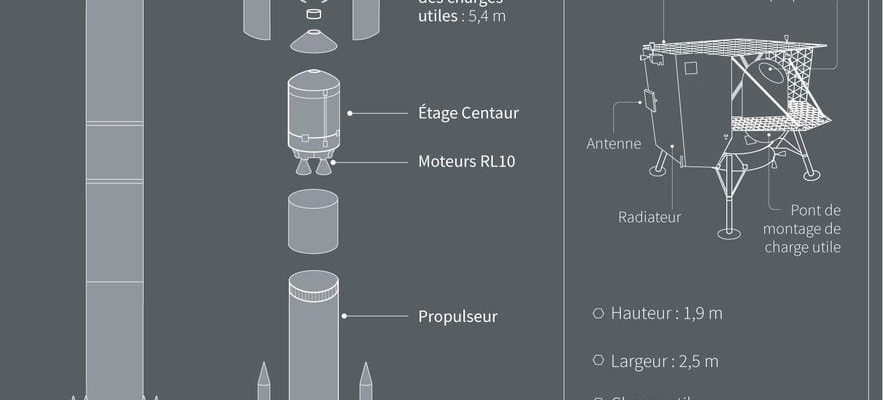Direction: the Moon. A brand new rocket took off from Florida this Monday, January 8, with on board the first American device to attempt to land on the Earth’s satellite in more than 50 years. The rocket, developed by the industrial group ULA, which brings together Boeing and Lockheed Martin, made its first flight from Cape Canaveral, tearing off from the ground at 2:18 a.m. local time, this Monday (7:18 a.m. GMT).
Base personnel applauded and shouted with joy at the separation of the launcher and the lunar spacecraft after some 48 minutes without incident, a key milestone for the private firm. An “impeccable” launch according to Eric Monda, ULA’s director of strategic planning.
The new American rocket Vulcan Centaur will carry the Peregrine lander on its first launch on January 8.
© / JEAN-MICHEL CORNU / AFP
The lander on board, named Peregrine, was developed by the start-up Astrobotic, with the support of NASA which commissioned this company to transport scientific equipment to the Moon – a contract worth some $108 million. (around 98,600,000 euros).
The launch should inaugurate a series of missions supported by the American space agency, which wishes to rely partly on the private sector for its lunar ambitions. If Astrobotic manages to land on the Moon as planned on February 23, it could become the first company to achieve this feat.
Risks of failure
“Leading America’s return to the surface of the Moon, for the first time since Apollo, is an immense honor,” declared Astrobotic boss John Thornton. However, he said he was aware of the difficulty of the task and the risks of failure. In recent years, Israeli and Japanese companies have attempted to land on the moon, but these missions have ended in crashes.
The program is precise. Approximately 50 minutes after liftoff, Peregrine must separate from the rocket: Astrobotic will then power up the device and attempt to establish communication. If all goes well, the lander will then continue its route towards our natural satellite. Once in lunar orbit, the probe will wait until the lighting conditions are right to attempt to land.
The targeted landing site is located on the visible side of the Moon, near mysterious domes formed by lava but which scientists struggle to explain. Thanks to the instruments sent, NASA must study the composition of the surface, as well as the radiation.
For the ULA industrial group, the Vulcan Centaur rocket represents the “future of the company”, says its vice-president, Mark Peller. The device, approximately 60 meters high, should allow it to replace its Atlas V and Delta IV launchers, and to compete with SpaceX with more affordable takeoffs. With six Vulcan Centaur launches planned this year, the group subsequently wishes to recover its engines after each flight to maximize its profitability.
Centers and DNA on board the rocket
However, the mission has also caused controversy because it carries the ashes or DNA of dozens of people, including those of Star Trek creator Gene Roddenberry. A partnership with the Celestis company, specializing in “commemorative spaceflights”. Sending these ashes to the Moon aroused the anger of the Navajo Native American tribe, who denounced the “desecration of a sacred place”, without however obtaining the postponement of the launch.
These missions studying the lunar environment should make it possible to prepare for the return of astronauts to the Moon, which NASA is planning with its Artemis program. To date, only the United States, the Soviet Union, China and India have succeeded in landing a device on the Moon.
A mission from the Japanese space agency (Jaxa) is also due to attempt to land on the moon in about two weeks. Russia, for its part, spectacularly missed a moon landing this summer.
